It couldn't have stayed obscure forever. Ko Lipe has officially joined the ranks of Thailand's most popular islands thanks to brilliant beaches and seascapes to rival the Maldives. Once tricky to reach due to a far-flung location, the tiny yet increasingly busy island is now served by a fleet of speedboats from multiple directions. It's a tried-and-true recipe for hordes of high-season travellers.
Tiny is the keyword. At only a few square kilometres and located some 60 kilometres off the Thai mainland, Lipe wasn't made for mass tourism. The native sea gypsies chose Lipe because this distant corner of the Andaman Sea was a good place to escape military conscription in the late 19th century. Who would come all the way out here to look for them?
As it turned out, travellers searching for unspoilt Eden would start trickling to Lipe in the 1980s. When Travelfish.org founder Stuart McDonald made his first trip in the '90s, "There were three places to stay and no roads, just a bush trail across the island. The one daily ferry took four or five hours from the mainland." More resorts and boats arrived in the 2000s, but changes were gradual.
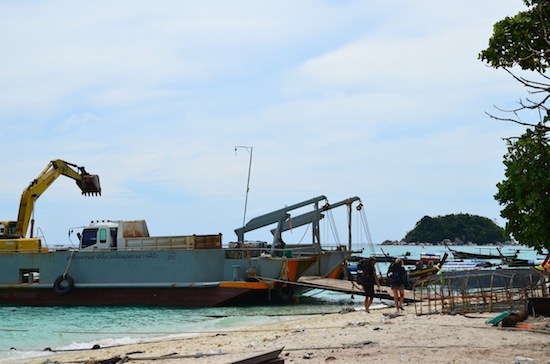
Make way for the machines.
Around 2010, the cross-island path was sealed and turned into "Walking Street." A few motorbikes arrived. Adding to more and faster mainland ferries, speedboats started connecting Lipe to Langkawi in Malaysia along with several other Thai islands. The mostly European and Australian travellers were joined by Japanese, Koreans, Russians and Chinese. With extra pocket cash from their growing economies, Thais and Malays began taking advantage of the paradise in their backyard.
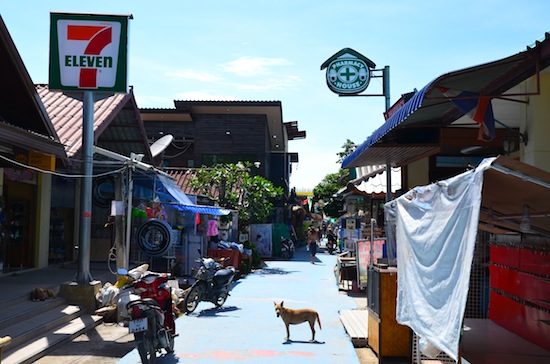
Used to be a sandy path.
Even so, after visiting in 2011 and again in '13, we felt that the islanders were preserving Lipe's natural beauty thanks in large part to an environmental campaign. Occasional visits from a Thai princess, who has a holiday home here, seemed to provoke local authorities to take good care of the island, retaining its low-key atmosphere. It felt like a balance had been struck.
Arriving again in November '14, we were shocked to see the difference that a year can make. New large-scale concrete development was everywhere. Simple bamboo bungalows were disappearing. Room rates were through the roof. The "Save Ko Lipe" banners were gone. A 7-eleven loomed over Walking Street. Seemingly to its detriment, the island was booming.
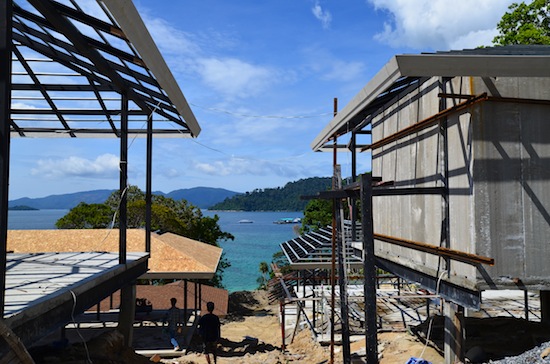
A common sight on Lipe today.
Along the beaches and inland, two- to three-storey concrete structures were popping up like sand crabs. Large resorts like Idyllic, Mountain and Bundhaya seemed set on stacking new concrete atop the old. The biggest resort of all, Sita, was almost finished building straight across the island. Several bungalow joints had closed after relinquishing land to developers eager to cash in on the demand for air-con rooms.
Not only is this bad news for Lipe's environment, but it's bad news for budget travellers too. It's now almost impossible to find a bungalow for under 1,000 baht on Sunrise beach in high season, and only a handful of backpacker-friendly joints hold out on Pattaya beach and inland. Many travellers who've been coming to Lipe for years are now forced to choose a less popular island -- or shell out considerably more cash.
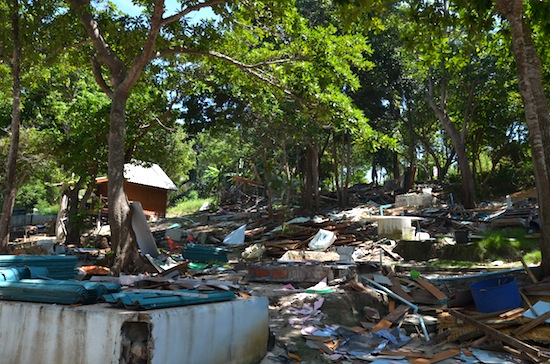
The remains of Porn's bungalows.
Long a place of guitar-strumming skinny dippers, Sunset beach has lost its budget mainstay, Porn Resort, which is being replaced by an upscale resort as we write this. Several other mid- to upper-range resorts are filling the area in. This makes us wonder: will Lipe's rugged western peninsula be next? An increase in barbed-wire fences and at least three new resorts way out in the remote reaches could hold a clue.
Large swathes of inland terrain are also being gobbled up. We figured that the many new hotels found here would be inexpensive given their considerable distance from the beaches and close proximity to the dump. Yet the misleadingly named The Green Resort and others charge more than 2,000 baht for plain air-con digs in high season. They've also replaced lush forest, cleared not too long ago, with an ugly view.
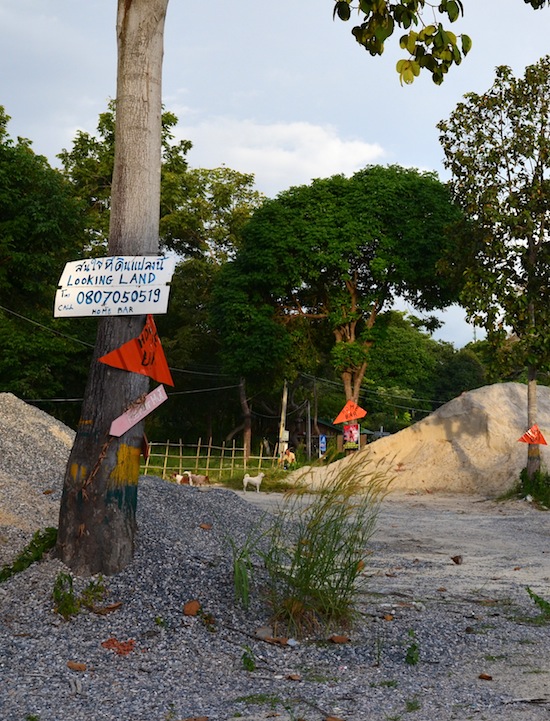
More to come.
This speaks volumes about the number of tourist arrivals compared to available rooms. At peak times in 2014, we were told, travellers who arrived without reservations were forced to sleep on the beaches. Highlighting an influx of weekending Thais and Malays, a staff member at Forra Diving who has been on Lipe for more than a decade said: "It used to be that every day was a Sunday. Now it's easy to tell weekdays from weekends by the crowds."
With bigger crowds come bigger piles of trash. Some resorts -- like Castaway and Serendipity -- do everything they can to manage waste and garbage responsibly, but plenty of others cut corners. Especially near construction sites, we often saw trash being burned, including plastic and styrofoam. Despite the efforts of Trash Hero, litter washes up from the sea and is commonly discarded by careless travellers and locals.
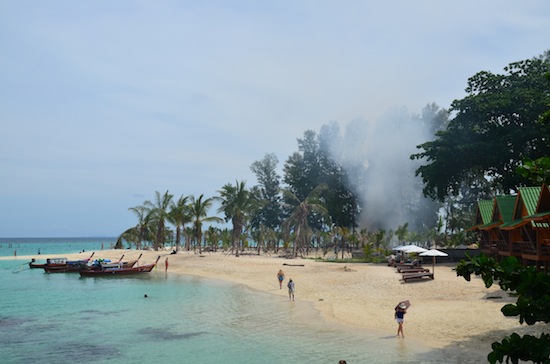
Toxic fumes don't go well with sunbathing.
Both at sea and on land, motorised traffic is everywhere on Lipe. A brigade of sidecar motorbike taxis shuttle travellers around an island that can be walked across in 15 minutes. Roads have been widened and extended, making room for pick-ups and the heavy cranes needed for construction. Walkers now have to constantly look out for vehicles, while boats threaten the snorkellers.
Part of Lipe's original charm came from its small community of Urak Lawoi, a traditionally nomadic "sea gypsy" group who lived in simple huts both here and on neighbouring Ko Adang. Now most work in tourism as boat drivers or servers. While a few have profited, our observations hint that some harbour apathetic or resentful attitudes towards the outsiders (including Thais) trammelling their home. Comfortable with English and Thai, as one native told us, they're forgetting their own language. This cultural degradation has a lot to do with assimilation through Thai education, but tourism also contributes.
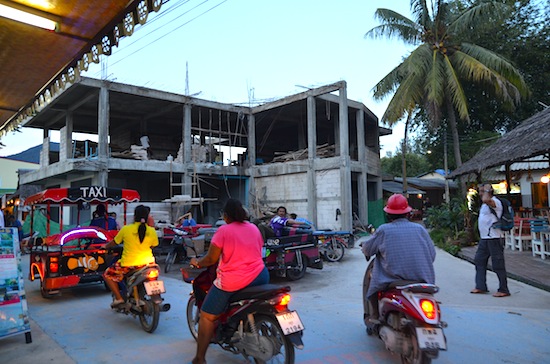
Traffic jam on Lipe?
By now you're probably thinking that Lipe is a write-off, but not all changes have been negative. A trash/recycling barge removes most of the garbage. Plans are underway to build a pier off Sunrise beach that will allow the barge and other boats to dock offshore, easing traffic near the beaches. To keep swimmers safe, several upscale resorts stopped boats from entering a large patch of sea off a stretch of Pattaya beach that's as stunning today as ever.
The increased popularity has resulted in a more convenient destination. Today you can buy an all-inclusive bus/boat ticket to Lipe from as far away as Bangkok, and airlines provide all-in "fly and ferry" tickets. Though choices are thin for backpackers, anyone with a bit of holiday cash has more accommodation choices than ever. Some of the newer resorts -- like Time to Chill and Mali -- blend tastefully (and responsibly) into the existing nature. And let's face it: it's nice to have an ATM around.
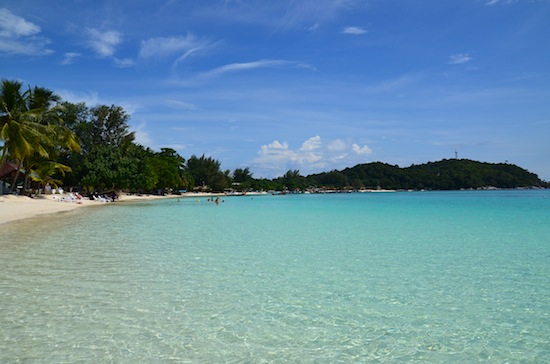
No complaints here.
Development has not extended to Lipe's 22 neighbouring islands, meaning that miles of untouched beaches and jungle are still only a boat ride away. A privately owned resort that was built illegally on Ko Adang in 2010 was still closed. Given the sometimes stricter enforcement of laws against national park land encroachment currently in Thailand, it probably won't open any time soon, if ever.
By building up to meet demand, Lipe is following the course taken by many other popular travel destinations. Anyone who visits Ko Phi Phi in peak season will probably find Lipe's crowds and development mild in comparison. Of course, many will ask if mass tourism is sustainable on both of these and many other islands. Are they too gorgeous for their own good?
Should limits be set on the number of travellers allowed on Lipe at any one time? Possibly. Should regulations on development and waste management be introduced and enforced? Certainly. And these issues are not confined to Lipe alone. Throughout Southeast Asia, dozens of destinations face similar questions. We hope that common sense, rather than greed and carelessness, guide the answers.